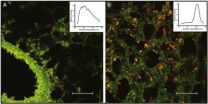(Press-News.org) COLUMBUS, Ohio – New research suggests that the addition of ultraviolet light to the brushing and suction of a vacuum cleaner can almost double the removal of potentially infectious microorganisms from a carpet's surface when compared to vacuuming alone.
Researchers say the findings suggest that incorporating the germicidal properties of UV light into vacuuming might have promise in reducing allergens and pathogens from carpets, as well.
"What this tells us is there is a commercial vacuum with UV technology that's effective at reducing surface microbes. This has promise for public health, but we need more data," said Timothy Buckley, associate professor and chair of environmental health sciences at Ohio State University and senior author of the study.
"Carpets are notorious as a source for exposure to a lot of bad stuff, including chemicals, allergens and microbes. We need tools that are effective and practical to reduce the associated public health risk. This vacuum technology appears to be a step in the right direction."
The research appears online in the journal Environmental Science & Technology.
For this study, Buckley and colleagues tested a commercially available upright vacuum cleaner, evaluating separately and in combination the standard beater-bar, or rotating brush, as well as a lamp that emits germicidal radiation.
UV-C light with a wavelength of 253.7 nanometers has been studied extensively for its disinfection properties in water, air and food and on a variety of surfaces. This is the first study of its effects on carpet surfaces.
The Ohio State research group selected multiple 3-by-3-foot sections of carpeting of different types from three settings: a commercial tight-loop carpet in a university conference room, and medium Berber carpet with longer, dense loops in a common room of an apartment complex and a single-family home.
Researchers collected samples from each carpet section using contact plates that were pressed onto the flooring to lift microbes from the carpet surfaces. They collected samples from various locations on each test site to obtain a representative sample of the species present on the carpets.
After sampling, the plates were incubated for 24 hours in a lab and the number of colonies was counted. The plates contained growth media particularly suited for fungi commonly found in indoor environments, including Penicillium and Zygomycetes.
Each treatment was tested separately by collecting multiple samples from each 3-by-3-foot section before and after treatment: vacuuming alone, the application of UV-C light alone, or a combination of UV-C light and vacuuming. In each case, the carpets were vacuumed at a speed of 1.8 feet per second for two minutes.
Overall, vacuuming alone reduced microbes by 78 percent, UV-C light alone produced a 60 percent reduction in microbes, and the combination of beater-bar vacuuming and UV-C light reduced microbes on the carpet surfaces by 87 percent. When looking at the microbe quantities, the researchers found that, on average, vacuuming alone removed 7.3 colony-forming units of microbes per contact plate and the UV-C light removed 6.6 colony-forming units per plate. The combination of UV-C light and vacuuming yielded the largest reduction in colony-forming units: 13 per plate.
"We concluded that the combined UV-C-equipped vacuum produced approximately the sum of the individual effects, and therefore the UV-C was responsible for an approximate doubling of the vacuum cleaner's effectiveness in reducing the surface-bound microbial load," Buckley said.
Surfaces in residential settings, and especially carpets, are seen as potentially posing health risks because they are reservoirs for the accumulation of a variety of contaminants. Those most susceptible to infection, including the elderly, asthmatics, the very young and people with compromised immune systems, might be at particular risk because they spend most of their time indoors, Buckley noted.
"The best next step would be to test this UV-C vacuum technology in some environments that are high risk, where we could sample for specific pathogens," Buckley said. "The home environment would be particularly important, because that's where people spend the lion's share of their time and are likely to be in close contact with carpet."
Most natural UV-C rays from the sun are absorbed in the atmosphere, but long-term exposure to artificial UV-C sources can cause skin and eye damage. The vacuum has been engineered to prevent exposure to harmful radiation from the UV-C lamp, Buckley said.
Upright vacuum retail prices generally range from about $100 to $900. The equipment in this study falls within that range.
###
This work was supported through a contract with Halo Technologies Inc. of Des Plaines, Ill., which supplied the vacuum technology.
Co-authors of the study include Eric Lutz, Smita Sharma and Bruce Casto of the Division of Environmental Health Sciences and Glen Needham of the Department of Entomology, all at Ohio State.
END
BUFFALO, N.Y. -- Researchers at the University at Buffalo have developed a novel technology using quantum dots that is expected to have major implications for research and treatment of tuberculosis, as well as other inflammatory lung diseases.
A paper appearing online in Nanomedicine: Nanotechnology, Biology and Medicine as an article-in-press describes specific delivery of a chemotherapeutic drug to specific cells in the lung, particularly the alveolar white cell, without causing acute inflammation.
Quantum dots are tiny semiconductor particles generally no larger ...
Washington, November 1, 2010 – Elderly women are at high risk for inappropriate urinary catheter utilization in emergency departments, according to a new study in the November issue of the American Journal of Infection Control, the official publication of the Association for Professionals in Infection Control and Epidemiology (APIC).
The study was conducted at St John Hospital and Medical Center, a 769-bed tertiary care teaching hospital in Detroit, Mich. The authors examined 532 instances in which urinary catheters were placed in emergency room patients over a 12-week ...
Along with energy conservation and storm-water reduction, scientists may soon be adding crime-fighting to the list of benefits that urban trees provide. Researchers with the U.S. Forest Service's Pacific Northwest (PNW) and Southern Research Stations have published a new study that suggests that certain types of city trees may help lower property and violent crime rates. Their study—which is posted online in advance of its appearance in a forthcoming printed issue of the journal Environment and Behavior—is the first to examine the effects of trees and other factors on crime ...
COLUMBIA, Mo. – It may seem difficult to change stereotypical thinking. Perceptions can be very important in forming an individual's attitudes. Now, researchers at the University of Missouri have found that people conditioned to think in opposition to racial stereotypes are more receptive to people from minority groups starring in commercial advertising.
Saleem Alhabash, a doctoral candidate in the University of Missouri School of Journalism.
"This research shows that when people are trained to think in a non-stereotypical way, they will pay more attention to ads with ...
GMOs, or Genetically Modified Organisms, may raise concerns of genes escaping from crops and having unknown effects on natural, wild species. But what is the real risk that traits associated with GMOs will actually migrate to and persist in their wild relatives? Interest in plant ecology, crop production and weed management led John Lindquist and his colleagues from the University of Nebraska and USDA-ARS to investigate how gene flow from a cultivated crop to a weedy relative would influence the ecological fitness of a cropwild hybrid offspring. They published their findings ...
WASHINGTON —People aren't very accurate at predicting how good or bad they'll feel after an event -- such as watching their team lose the big game or getting a flat-screen TV. But afterwards, they "misremember" what they predicted, revising their prognostications after the fact to match how they actually feel, according to new research.
These findings appear in the November issue of the Journal of Experimental Psychology: General, published by the American Psychological Association.
Although the process of predicting emotions seems imprecise from start to finish, misremembering ...
To a hungry fish on the prowl, the split-second neural processing required to see, track, and gobble up a darting flash of prey is a matter of survival.
To scientists, it's a window into how our brain coordinates the eye motions that enable us to hit a baseball, sidestep an errant skateboarder, and otherwise make our way in a world full of danger and opportunity.
This process is now better understood, thanks to a team of scientists that imaged the activity of individual neurons in a part of a zebrafish's brain called the optic tectum. The optic tectum receives signals ...
When Stephen Barrager was diagnosed in 2007 with acute multiple myeloma, a form of bone marrow cancer, he endured the same anxiety that troubles all those who receive an upsetting diagnosis. The way he went about dealing with his disease and its treatment, however, was different. Barrager drew upon his engineering and management science background to help him make difficult decisions. Now he is sharing his insights with hospitals and doctors in his native Bay Area and with colleagues at a conference coming to Austin on Nov. 7, 2010.
The annual meeting of the Institute ...
Orange, Calif., Nov 1, 2010 — A UC Irvine oncologist's work with a targeted therapy is showing great promise in patients with a deadly form of lung cancer. The results were published Thursday in the New England Journal of Medicine.
The multicenter study is testing whether the drug crizotinib effectively slows, stops or reverses growth in advanced non-small cell lung cancer tumors by targeting a genetic mutation that causes uncontrolled tumor growth. Study participants all tested positive for a mutation in the anaplastic lymphoma kinase gene.
According to the findings, ...
It is one thing to learn a new piece of information, such as a new phone number or a new word, but quite another to get your brain to file it away so it is available when you need it.
A new study published in the Journal of Neuroscience by researchers at the University of York and Harvard Medical School suggests that sleep may help to do both.
The scientists found that sleep helps people to remember a newly learned word and incorporate new vocabulary into their "mental lexicon".
During the study, which was funded by the Economic and Social Research Council, researchers ...

